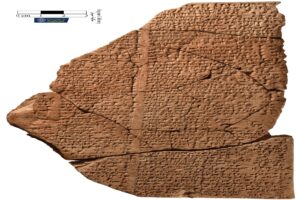It’s always been hard to say just who first set foot on the shores of New England when European settlers began to arrive in America. Like many colonial endeavors, the colonization was performed by people on the fringes of society: religious radicals, soldiers of fortune, and so on. That the vast majority of their personal histories don’t survive is no surprise.
But that can all change at the discovery of a primary object — like the skeleton of a teenage boy who arrived among the first European settlers in what is now Maryland.
Researchers told The Washington Post the boy could have sailed on either the Ark or the Dove, which both landed in 1634.

A reconstruction of the ‘Dove’ at modern-day Historic St. Mary’s City. Photo: Wiki Commons
Hard landings
At the time, the boy’s people claimed a fragile foothold on American soil. The first European settlement to survive catastrophe was Jamestown. Minimally stable by 1610, its people had weathered many grave threats.
Who was this young settler? Experts found he “had a square jaw,” stood around five feet tall and was about 15 years old when he died, the Post reported. Little ceremony seems to have accompanied his death.
The excavation revealed no coffin and no burial shroud to protect a body with a broken right leg and possibly damaged ribs. Buried with one arm bent awkwardly across his chest and his left hand clenched in a fist, it’s possible he had no family to mourn him.
Travis Parno is the director of research and collections for Historic St. Mary’s City, Maryland’s colonial capital and the location of the remains. Though the boy’s status during life merited meager rites at best, his existence is now “monumental,” Parno told the Post.
“This is someone who was here in the first years of the settlement, the vanguard of the Colonial invasion,” said Parno, standing at the site. “Someone nobody wrote about. It’s a period that we have such little documentation on.”
He continued: “You wonder…what he came over for… the hopes that he had, the dreams that he had.”

“The Founding of Maryland,” 1634. Colonists are depicted meeting the Piscataway Indians in St. Mary’s City. A Jesuit missionary, Father Andrew White, is believed to be on the left. In front of him, the colonists’ leader Leonard Calvert clasps hands with the chief of the Yaocomico. Photo: Wiki Commons
Harder life
Researchers extrapolated the boy’s age and ancestry through his skeletal and facial structure. His grave was located just outside the walls of a long-lost fort, which Parno and his team discovered just two years ago. The structure, they said, is the earliest archaeological site in Maryland.

The original St. Mary’s City fort. Image: Historic St. Mary’s City
The fort occupied the site of a former Yaocomico (also spelled Yaocomaco) Indian village, but the rest of colonial St. Mary’s City fought hard to plant and grow crops with the novel methods the landscape forced them to learn.
Most immigrants lived as servants
Indentured servants formed the “backbone” of the 17th-century settlement, a historical account of the colony asserted. About 70-85 percent of immigrants there arrived under some agreement of servitude.
Research suggests that the boy was one of these immigrants. Kari Bruwelheide, a biological anthropologist at the Smithsonian’s National Museum of Natural History, advised the Post on the remains. The most likely reason for his meager burial, she said, was that he made the journey to the New World alone.
“If he had family here, they would have buried him a little more ceremoniously,” Bruwelheide said. “So we can assume he had no family. He was a 15-year-old boy. A lot of ship crews at the time had cabin boys.”
He probably suffered the trauma to his leg, which included a tib-fib fracture (highly painful, as anyone who’s been there knows) shortly before he died, Bruwelheide told the Post.
Ultimately, he went the way of the colony itself. When the state government moved to Annapolis in 1694, conditions at the old capital deteriorated quickly.

Common lodgings in colonial St. Mary’s City (reconstruction). Photo: Wiki Commons
His remains will now make the 110-kilometer journey to Washington D.C., for detailed examination at the Smithsonian Institution. After that, they’ll go back to St. Mary’s City for reburial, Parno said, in a “suitable location.”
It’s unclear whether they’ll cover what’s left in a casket or shroud.






